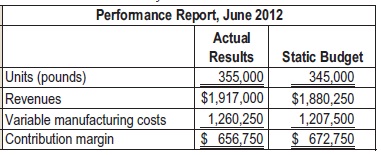Problem:
Flexible-budget and sales volume variances, market-share and market-size variances. Marron, Inc., produces the basic fillings used in many popular frozen desserts and treats-vanilla and chocolate ice creams, puddings, meringues, and fudge. Marron uses standard costing and carries over no inventory from one month to the next. The ice-cream product group's results for June 2012 were as follows:

Ted Levine, the business manager for ice-cream products, is pleased that more pounds of ice cream were sold than budgeted and that revenues were up. Unfortunately, variable manufacturing costs went up too. The bottom line is that contribution margin declined by $16,000, which is less than 1% of the budgeted revenues of $1,880,250. Overall, Levine feels that the business is running fine. Levine would also like to analyze how the company is performing compared to the overall market for ice-cream products. He knows that the expected total market for ice-cream products was 1,150,000 pounds and that the actual total market was 1,109,375 pounds.
Required
1. Calculate the static-budget variance in units, revenues, variable manufacturing costs, and contribution margin. What percentage is each static-budget variance relative to its static-budget amount?
2. Break down each static-budget variance into a flexible-budget variance and a sales-volume variance.
3. Calculate the selling-price variance.
4. Calculate the market-share and market-size variances.
5. Assume the role of management accountant at Marron. How would you present the results to Ted Levine? Should he be more concerned? If so,why?